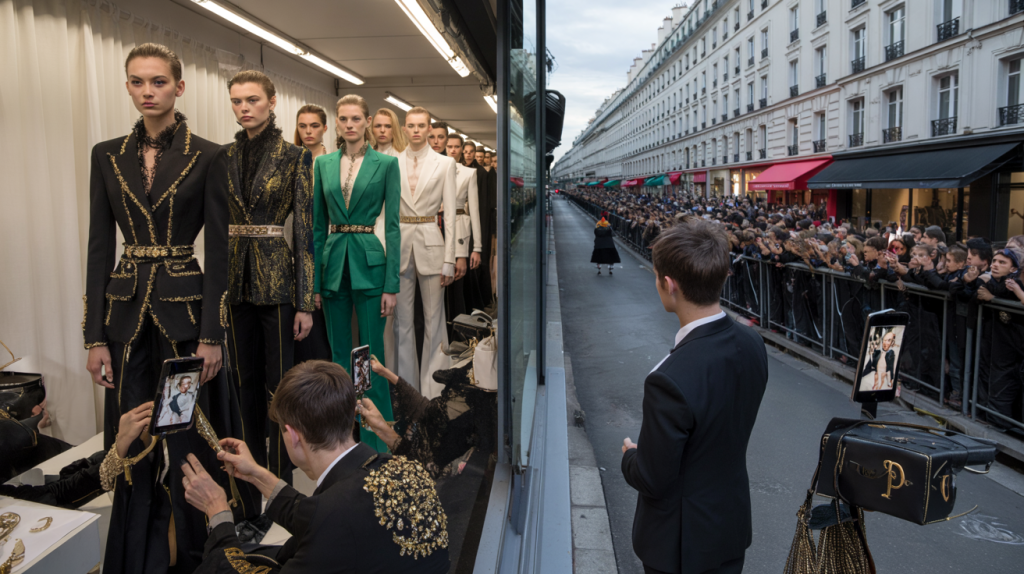Looking for what really changed at Balmain under Olivier Rousteing, and why it still resonates on runways and in street style alike ? Here is the quick answer : a 2011 appointment at 25, a mass-appeal spike in 2015, an ownership shift in 2016, a bold new logo in 2018, and a couture comeback in 2019. Clear markers, lasting effects.
That arc tells a story of acceleration. Olivier Rousteing bridged Paris heritage and pop culture, pulled celebrities into the atelier, and scaled visibility through social-first storytelling. The house kept its sharp tailoring and embellishment while gaining reach across price ladders and platforms. The legacy sits right there.
Olivier Rousteing at Balmain : the legacy in one glance
Fact first. In April 2011, Olivier Rousteing became creative director at Balmain at 25, following Christophe Decarnin, and joined the very short list of the youngest to steer a major Paris house, as documented by Vogue and The Guardian.
The pivot to mass excitement arrived on 5 November 2015 with Balmain x H&M : the capsule launched in roughly 250 stores worldwide and online, sold out within hours, and crashed traffic across markets, according to H&M communications and global retail coverage.
Ownership changed the following year. In 2016, Qatar’s Mayhoola for Investments bought Balmain in a deal reported at about 485 million euros, noted by Reuters. That backed international rollout and category depth.
Then came identity work. In December 2018, Balmain unveiled a new wordmark and revived PB monogram under Olivier Rousteing, reported by Business of Fashion, tying archival geometry to a contemporary grid.
And in January 2019, the house returned to haute couture after a pause of around 16 years, covered by Vogue. The move reactivated historical codes at the highest craft level, using the Paris atelier as narrative engine.
2011 to 2019 : milestones that shaped modern Balmain
The idea is simple : connect high craft with high visibility. The execution traveled through precise steps, each time with a date and a lever.
- 2011 : Olivier Rousteing takes the helm at 25, sharpening the shoulder line, ornaments, and a club-ready silhouette anchored in house heritage.
- 2015 : Balmain x H&M launches in about 250 stores, queues form before opening, and pieces sell out the same day across major cities.
- 2016 : Mayhoola acquires Balmain for an estimated 485 million euros, per Reuters, fueling expansion and retail modernization.
- 2018 : New logo and PB monogram debut in December, aligning brand architecture with the archive and digital formats.
- 2019 : Couture returns in Paris after approximately 16 years, re-centering savoir-faire as a competitive edge.
Pop culture reach and the Balmain Army : how it scaled
Visibility did not happen by accident. Olivier Rousteing invited stars into the process and turned fittings into culture moments. Beyoncé wore custom Balmain for Coachella in April 2018, a performance chronicled across global media. The look matched the house’s military beading with stadium-scale impact.
Then, an even deeper co-creation landed in March 2023 : “Renaissance Couture by Beyoncé x Balmain”, a 16-look couture capsule announced via Vogue France and WWD. It connected album tracks to atelier techniques, and it showed how pop and couture can share a single narrative spine.
Social-first language amplified it all. The “Balmain Army” reframed the house as a community, where fans and celebrities circulate the same silhouettes. Runway, red carpet, and retail moved in sync. Campaigns often featured musicians and models known first to smartphone audiences, then to the front row.
Resilience also marked the timeline. In September 2023, a truck carrying around 50 looks for Paris Fashion Week was hijacked before delivery, a fact Olivier Rousteing disclosed publicly and that WWD reported. The team rebuilt missing pieces at speed, and the show went on. That episode underlined a reflex : adapt fast, keep the promise.
What remains of Olivier Rousteing’s heritage at Balmain today
Across these chapters runs one through line : archive craft turned live culture. Sharp shoulders, ornate surfaces, and sculpted jackets became recognisable signatures in nightlife, on stages, and in feed-friendly campaigns. The 2018 logo system and PB monogram still organize brand language across leather goods and ready-to-wear.
The couture revival changed the internal rhythm. It refocused attention on the atelier, embroidery partners, and fabric innovation, then filtered ideas back into ready-to-wear. That loop helps a house maintain scarcity at the top and momentum on the shop floor, a model many luxury players pursue, as industry analyses regularly point out.
Partnership logic also remains. The 2015 collaboration validated a ladder from aspirational entry to high-end lines. Later capsules and celebrity wardrobes kept the spotlight warm between runway seasons. When a star steps out in a freshly tailored Balmain blazer, the archive silhouette travels again.
And yes, the community piece still counts. A designer can speak directly to millions, then measure response in real time. That feedback has shaped casting, show soundtracks, even palette choices. Not everything needs to be perfect to work. Sometimes a bold move hits the mood and definitly sets the tone for a season.
One last marker links back to the house founder, Pierre Balmain : the belief that couture rigor and social life can share the same garment. Under Olivier Rousteing, that principle shifted into a digital century and met a new audience. The result feels set in dates and facts above, with new chapters already drafting backstage.
